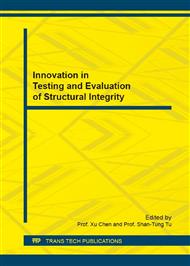p.272
p.276
p.281
p.286
p.291
p.296
p.301
p.306
p.311
Quantification of Stress Field for Mixed Mode Creep Crack Considering Mismatch Effect
Abstract:
Accurate description of creep crack stress field is very important to characterize the creep crack growth of the structures at elevated temperature. In general, the crack mode in practical engineering practices is not mere the mode I or mode II, and it is the mixed mode. The mismatch effect in weldment is also concerned by many researchers, however, there is no available literatures to discuss the stress field of mixed mode creep crack yet. The overall aim of this paper is to investigate and qualify the distribution of stress field for the mixed mode creep crack. In this paper, a mixed mode creep crack within the mismatched plate is discussed. The stress distribution of mixed mode creep crack are given in this article. With the definition of mode mixity for creep crack, the influence of mode mixity on the stress field is presented. The influence of mismatch effect on the principal stress, open stress and shear stress for mixed mode creep crack is also figured out. The main factor leads to the variation of creep crack tip stress field for mixed creep crack is analyzed. Some useful guidelines are proposed for the engineering purpose of integrity assessment for the structure at high temperature.
Info:
Periodical:
Pages:
291-295
Citation:
Online since:
September 2016
Authors:
Keywords:
Price:
Сopyright:
© 2017 Trans Tech Publications Ltd. All Rights Reserved
Share:
Citation:


